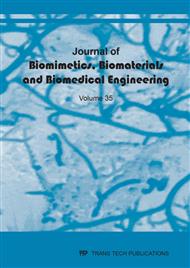[1]
G.E. Guzy and J.I. Nicholls, In vitro comparison of intact endodntically treated teeth with and without endo-post reinforcement, J. Prosthet. Dent. 42 : 39-44, (1979).
DOI: 10.1016/0022-3913(79)90328-7
Google Scholar
[2]
M. Trope and D.O. Maltz, Resistance to fracture of restored endodontically treated teeth, Endod. Dent. Traumatol. 1: 108-111, (1985).
DOI: 10.1111/j.1600-9657.1985.tb00571.x
Google Scholar
[3]
S.M. Morgano, Restoration of pulpless teeth: Application of traditional principles in present and future contexts, J. Prosthet. Dent. 75 : 375-380, (1996).
DOI: 10.1016/s0022-3913(96)90028-1
Google Scholar
[4]
G. Heydecke, F. Butz and J.R. Strub, Fracture strength and survival rate of endodontically treated maxillary incisors with approximal cavities after restoration with different post ansystems: an in-vitro study, J. Dent. 29 : 427-433, (2001).
DOI: 10.1016/s0300-5712(01)00038-0
Google Scholar
[5]
Wasim, M.K. Helal & Shi, D.Y. Determining the optimum elastic modulus and Poisson's ratio for an Endodontic Prefabricated Post, Proceeding of The 2nd International Conference on Advanced Materials, Mechanics and Structural Engineering (AMMSE 2015), Je- ju Island, South Korea, September 18-20, (2015).
DOI: 10.1201/b19934-55
Google Scholar
[6]
Trabert, K.C. & Cooney, J.P. The endodontically treated tooth: restorative concepts and techniques, Dental Clinics of North America, 28(4): 923-951, (1984).
DOI: 10.1016/s0011-8532(22)02214-5
Google Scholar
[7]
Richard S. Schwartz, DDS, and James W. Robbins, DDS, MA, Post Placement and Restoration of Endodontically Treated Teeth: A Literature Review, JOURNAL OF ENDODONTICS, VOL. 30, NO. 5, MAY , (2004).
DOI: 10.1097/00004770-200405000-00001
Google Scholar
[8]
William C., D.M.D., A review of the management of endodontically treated teeth, J.A.D.A. 136 611-619, (2005).
Google Scholar
[9]
Standlee JP, Caputo AA, Hanson EC. Retention of endodontic dowels: effects of cement, dowel length, diameter, and design. J Prosthet Dent; 39: 401-5, (1978).
DOI: 10.1016/s0022-3913(78)80156-5
Google Scholar
[10]
Felton DA, Webb EL, Kanoy BE, Dugoni J. Threaded endodontic dowels: effect of post design on incidence of root fracture. J Prosthet Dent1; 65: 179–87, (1991).
DOI: 10.1016/0022-3913(91)90159-t
Google Scholar
[11]
Johnson JK, Sakamura JS. Dowel form and tensile force. J Prosthet Dent; 40: 645-9, (1978).
Google Scholar
[12]
Standlee JP, Caputo AA, Hanson EC. Retention of endodontic dowels: effects of cement, dowel length, diameter, and design. J Prosthet Dent; 39(4): 400-5, (1978).
DOI: 10.1016/s0022-3913(78)80156-5
Google Scholar
[13]
Qualtrough AJ, Chandler NP, Purton DG. A comparison of the retention of tooth-colored posts. Quintessence Int; 34(3): 199-201, (2003).
Google Scholar
[14]
Martinez-Insua A, da Silva L, Rilo B, Santana U. Comparison of the fracture resistances of pulpless teeth restored with a cast post and core or carbon-fiber post with a composite core. J Prosthet Dent; 80(5): 527-32, (1998).
DOI: 10.1016/s0022-3913(98)70027-7
Google Scholar
[15]
Sorensen JA, Engelman MJ. Ferrule design and fracture resistance of endodontically treated teeth. J Prosthet Dent; 63(5): 529-36, (1990).
DOI: 10.1016/0022-3913(90)90070-s
Google Scholar
[16]
Isidor F, Brondum K. Intermittent loading of teeth with tapered, individually cast or prefabricated, parallel-sided posts. Int J Prosthodont; 5(3): 257-61, (1992).
Google Scholar
[17]
Martinez-Insua A, da Silva L, Rilo B, Santana U. Comparison of the fracture resistances of pulpless teeth restored with a cast post and core or carbon-fiber post with a composite core. J Prosthet Dent; 80: 527-32, (1998).
DOI: 10.1016/s0022-3913(98)70027-7
Google Scholar
[18]
Sorensen JA, Engelman MJ. Ferrule design and fracture resistance of endodontically treated teeth. J Prosthet Dent; 63: 529-36, (1990).
DOI: 10.1016/0022-3913(90)90070-s
Google Scholar
[19]
Isidor F, Brondum K. Intermittent loading of teeth with tapered, individually cast or prefabricated, parallel-sided posts. Int J Prosthodont; 5: 257-61, (1992).
Google Scholar
[20]
Asmussen, E. Peutzfeldt, A. & Sahafi 2005. Finite element analysis of stresses in endodontically treated, dowel-restored teeth, Journal of Prosthetic Dentistry, 94(4): 321-329.
DOI: 10.1016/j.prosdent.2005.07.003
Google Scholar
[21]
Chen, J. & Xu, L.J. 1994. A Finite Element Analysis of the Human Temporomandibular Joint, Journal of Biomechani-cal Engineering, 116(4): 401-407.
Google Scholar
[22]
Wasim, M.K. Helal & Shi, D.Y. Stress Distribution Sur-rounding Endodontic Prefabricated Parallel Post, Applied Mechanics and Materials, 752: 39-43, (2015).
DOI: 10.4028/www.scientific.net/amm.752-753.39
Google Scholar
[23]
Song, G.Q. Three-dimensional finite element stress analysis of post-core restored endodontically treated teeth, master's dissertation, Master of Science, University of Manitoba, Winnipeg, Manitoba, Canada. (2005).
Google Scholar
[24]
Viguie, G. Malquarti, G. Vincent, B. & Bourgeois, D. Epoxy/carbon composite resins in dentistry: Mechanical properties related to fiber reinforcements. Journal of Prosthetic Dentistry. 72(3): 245-249, (1994).
DOI: 10.1016/0022-3913(94)90336-0
Google Scholar
[25]
Lanza, A., Aversa, R., Rengo, S., Apicella, D. & Apicella, A. 3D FEA of cemented steel, glass and carbon posts in a maxillary incisor. Dental Materials : Official Publication of the Academy of Dental Materials. 21(8): 709-715, (2005).
DOI: 10.1016/j.dental.2004.09.010
Google Scholar
[26]
Suansuwan, N. & Swain, M.V. Determination of elastic properties of metal alloys and dental porcelains. Journal of oral rehabilitation. 28(2): 133-139, (2001).
DOI: 10.1046/j.1365-2842.2001.00642.x
Google Scholar
[27]
SoX. Li, B. Bhushan, P.B. McGinnis. Nanoscale mechanical characterization of glass fibers. Materials Letters. 29: 215-220, (1996).
DOI: 10.1016/s0167-577x(96)00154-1
Google Scholar
[28]
G.H. Zhou, S. W Wang, J.K. Guo, Z. Zhang. The preparation and mechanical properties of the unidirectional carbon fiber reinforced zirconia composite. Journal of the European Ceramic Society. 28: 87-792, (2008).
DOI: 10.1016/j.jeurceramsoc.2007.07.005
Google Scholar
[29]
Mojtaba MAHMOUDI, Alireza SAIDI, Saied Abdolreza GANDJALIKHAN NASSAB and Maryam Alsadat HASHEMIPOUR. A three-dimensional finite element analysis of the effects of restorative materials and post geometry on stress distribution in mandibular molar tooth restored with post-core crown. Dental Materials Journal. 31(2): 171-179, (2012).
DOI: 10.4012/dmj.2011-138
Google Scholar
[30]
Hong, S. Y, Lisa, A.L. Anthony, M. & David, A.F. The effects of dowel design and load direction on dowel-and-core restorations. Journal of Prosthetic Dentistry. 85: 558-567, (2001).
DOI: 10.1067/mpr.2001.115504
Google Scholar
[31]
ANSYS User's Manual, Version 12. 1.
Google Scholar


